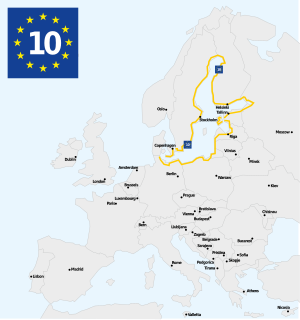Baltic Sea Route (EV10)
The Euro Velo route EV10 (Baltic coastal route) also Baltic Sea Cycle Route , Hansa route , International Baltic Sea Cycle Route (Hansa circuit) called, is a European cycle track. It leads around 7,980 kilometers around the Baltic Sea.
Routing
Denmark
The Danish part runs from Amager on the coast of Zealand south of København via Køge , Faxe Ladeplads , Præstø and meets the Østersøruten at Kalvehave, over which it continues to the German border. The route then runs over the island of Møn through footbridges , and via Bogø By to the island of Falster through Marielyst and Nykøbing and further on the island of Lolland through Maribo to Nakskov . Over the small island of Langeland to Svendborg on Fyn , through Fåborg and Assens to Middelfart . In Kolding you are back on the mainland and drive in Jutland through Christiansfeld , Haderslev , Aabenraa , Sønderborg , Gråsten to the border at Padborg .
Germany
In Germany the route corresponds to the D-Netz route D2 Baltic Sea coast route .
From Flensburg along the fjord to Glücksburg and further along the Baltic Sea coast via Kappeln and Eckernförde to Kiel . Via Hohwacht and Heiligenhafen the route reaches the island of Fehmarn . After circumnavigating the island, the route leads via Dahme, Kellenhusen and Grömitz to Neustadt in Holstein , Travemünde and on to Wismar and via Kühlungsborn to Warnemünde . Stralsund is reached via the Darß , from where a tour around the island of Rügen begins. Back on the mainland, the route runs via Greifswald to Usedom , where the border to Poland is reached at Ahlbeck .
Poland
The route leads in Poland from Świnoujście via Rewal , Trzebiatów , Mrzeżyno , Kołobrzeg , Darłowo , Ustka , Główczyce , Krokowa , Gdynia , Gdańsk , Kadyny and Frombork and reaches the border at Gronowo .
Russia (Kaliningrad)
From the border on the A194 road to Kaliningrad , Svetlogorsk and Zelenogradsk , from there to the Curonian Spit to the border crossing at Morskoye .
Lithuania
From Nida on the Curonian Spit to Klaipėda and then via Palanga to the border to Latvia.
Latvia
From the Lithuanian border to the seaside resort of Liepāja and on to Jūrkalne, then inland via Kuldīga , southeast past Talsi to Tukums and via Jūrmala to Riga . Via Ropaži and Sigulda further inland to Limbaži and Salacgrīva , where the route meets the coast again and reaches the border to Estonia at Ainaži .
Estonia
In Estonia, the route goes along the coast to Pärnu and on to Virtsu . The further route runs over the island of Muhu to the island of Saaremaa , which is largely circled. It happens Kuressaare . Next, the route crosses Hiiumaa Island and then, back on the mainland, to Haapsalu . Via Nõva , Padise and Laulasmaa it goes to the capital Tallinn . The route continues eastwards past the Lahemaa National Park and through Kohtla-Järve and Sillamäe to Narva .
Russia
For the Russian parts of the route in Leningrad Oblast, there is still no fixed route.
The cycle path should lead from the Estonian-Russian border near Ivangorod via Kingissepp . A continuation close to the coast must take into account the military restricted areas and the restricted area around the nuclear power plant near Sosnowy Bor . The use of the coastal road is only permitted with a special permit. It is therefore advisable to follow the route of the European cycle route R1 . This meets again at Peterhof on the Baltic Sea and continues to Saint Petersburg .
Finland
In Finland, a few kilometers beyond the Finnish-Russian border at Virolahti , the route meets cycle path no. 7 Helsinki – Lappeenranta and follows it via Hamina , Kotka , Ruotsinpyhtää , Porvoo to Helsinki . From Helsinki the route follows the national cycle route No. 1 Helsinki – Turku via Kirkkonummi , Pohja and Salo to Turku . From there via Naantali , Merimasku , Taivassalo , Uusikaupunki , Rauma , Eurajoki , Luvia to Pori . The rest of the way to the Finnish-Swedish border follows the national routes No. 8 to Oulu and from Oulu to Keminmaa the No. 4. From there to the Swedish border No. 21. The entire route is well signposted.
Sweden
In Sweden, the route corresponds to the Cykelspåret along the east coast , a national cycle route that runs for around 2,400 km along the entire east coast of Sweden.
From Haparanda on the border with Finland, the route runs via Kalix , Luleå , Piteå , Skellefteå , Umeå , Örnsköldsvik , Sundsvall , Hudiksvall , Söderhamn , Gävle , Österbybruk , Norrtälje , Täby to Stockholm . Next on Tumba , Trosa , Nyköping , Söderköping , Valdemarsvik , Loftahammar, Västervik , Figeholm, Oskarshamn , Mönsterås , Timmernabben past Kalmar , Torsås , Jämjö, Nättraby, Karlshamn , Pukavik, Sölvesborg , Åhus , Simrishamn , Ystad , Trelleborg up to Malmö .
The cycle path has been implemented and is signposted from Haparanda to Ystad with a blue sign with a bicycle symbol and the inscription Cykelspåret. In the north, the cycle path is partly led via the E4 motorway .
Web links
- ECF: EuroVelo 10
- Bicycle Routes & Tours: EuroVelo - Baltic Sea Cycle Route EV10
- Baltic Sea Cycle Route on the Schleswig-Holstein Baltic Sea coast
Individual evidence
- ↑ EuroVelo Map , from www.eurovelo.com, accessed on December 27, 2018

